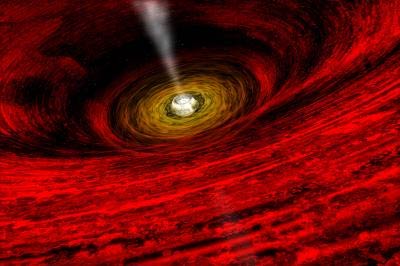Monster Black Holes May Grow in Giant Star Cocoons

The biggest black holes in the universe are also the mostperplexing. Scientists have long been confused about just how the earliest,most massive black holes formed, but new evidence now suggests they could have originatedinside giant cocoon-like stars.
This idea is at odds with the prevailing thinking that largeblack holes are created by the clumping together of smaller black holes.
Not so, says University of Colorado at Boulderastrophysicist Mitchell Begelman. Rather, these behemoth black holes likelyformed in the middle of even larger supermassive stars that could have held tensof millions of times the mass of our sun, according to Begelman.
"Until recently, the thinking by many has been that supermassiveblack holes got their start from the merging of numerous, small black holesin the universe," Begelman said. "This new model of black holedevelopment indicates a possible alternate route to their formation."
Begelman studied how these gigantic stars could have formed,and how massive their cores might have been, to understand how they might havegiven rise to huge black holes. The results of his investigation will bepublished in an upcoming issue of the Monthly Notices of the Royal AstronomicalSociety in London.
The monster stars probably started forming within the first fewhundred million years after theBig Bang, which is thought to have created the universe around 14 billionyears ago, Begelman found. When the cores of these giant stars had burned alltheir hydrogen, they would have collapsed, forming dense black holes. Meanwhilethe outside gas layers of the stars remained as a shroud. Eventually, though,the black holes would have swallowed all the remaining stellar matter withintheir reach, ballooning rapidly to staggering weights, the study suggests.
This scenario could be more likely than the clumping processas the origin of supermassive black holes, Begelman said, though it's also possiblethat both methods have occurred.
Get the Space.com Newsletter
Breaking space news, the latest updates on rocket launches, skywatching events and more!
"The problem that most people see in the clumpingmechanism is whether you get these small black holes to merge frequently enough,"Begelman told SPACE.com. "I'm working on trying to compare the rates ofthese two processes."
Over time, the resulting black boles might have merged withother giant black holes to form even larger leviathans.
"Big black holes formed via these supermassive starscould have had a huge impact on the evolution of the universe, including galaxyformation," Begelman said.
Astronomers think most galaxies, includingthe Milky Way in which the Earth?s solar system resides, have supermassiveblack holes at their centers. These black holes are probably responsible for acosmic phenomenon called quasars, which are thought to occur when mass poursonto huge black holes, and some material is flung away in bright jets ofhigh-energy radiation that can be seen across the universe.
- Video Show: The Black Hole That Made You Possible
- Video ? Slow Birth of a Black Hole
- Top 10 Strangest Things in Space
?
Join our Space Forums to keep talking space on the latest missions, night sky and more! And if you have a news tip, correction or comment, let us know at: community@space.com.

Clara Moskowitz is a science and space writer who joined the Space.com team in 2008 and served as Assistant Managing Editor from 2011 to 2013. Clara has a bachelor's degree in astronomy and physics from Wesleyan University, and a graduate certificate in science writing from the University of California, Santa Cruz. She covers everything from astronomy to human spaceflight and once aced a NASTAR suborbital spaceflight training program for space missions. Clara is currently Associate Editor of Scientific American. To see her latest project is, follow Clara on Twitter.









